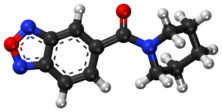Farampator
 | |
 | |
| Clinical data | |
|---|---|
| Other names | CX-691; ORG-24448 |
| Legal status | |
| Legal status | |
| Identifiers | |
| |
| CAS Number | |
| PubChem CID | |
| ChemSpider | |
| UNII | |
| KEGG | |
| CompTox Dashboard (EPA) | |
| Chemical and physical data | |
| Formula | C12H13N3O2 |
| Molar mass | 231.255 g·mol−1 |
| 3D model (JSmol) | |
| |
| |
| | |
Farampator (developmental code names CX-691, ORG-24448, SCH-900460) is an ampakine drug. It was developed by Cortex Pharmaceuticals, and licensed to Organon BioSciences for commercial development. Following the purchase of Organon by Schering-Plough in 2007, the development license to farampator was transferred. The development of farampator was eventually terminated, reportedly due to concerns about cardiac toxicity.[1][2]
Farampator has been investigated for its effect on AMPA receptors and researched for potential use in the treatment of schizophrenia and Alzheimer's disease. It was found to improve short-term memory, but impaired episodic memory. It produced side effects such as headache, somnolence and nausea. Subjects reporting side effects had significantly higher plasma levels of farampator than subjects without.[citation needed] Additional analyses revealed that in the farampator condition the group without side effects showed a significantly superior memory performance relative to the group with side effects.[3]
See also
References
- ^ "Farampator - AdisInsight".
- ^ Froestl W, Muhs A, Pfeifer A (2012). "Cognitive enhancers (nootropics). Part 1: drugs interacting with receptors". J. Alzheimers Dis. 32 (4): 793–887. doi:10.3233/JAD-2012-121186. PMID 22886028.
- ^ Wezenberg E, Verkes RJ, Ruigt GS, Hulstijn W, Sabbe BG (Jun 2007). "Acute effects of the ampakine farampator on memory and information processing in healthy elderly volunteers". Neuropsychopharmacology. 32 (6): 1272–83. doi:10.1038/sj.npp.1301257. PMID 17119538.
